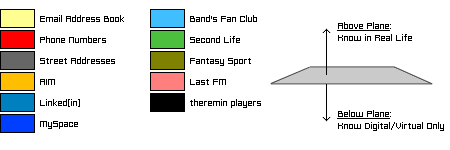Among a certain group of fraternizing marketing bloggers, that I myself have been known to cavort with from time to time, there is a meme that has swept the conversation: Web 2.0 has grown out of control— with new social media apps launching on a twice-daily basis, how can the poor user keep up with it all? While I commiserate with this plight, I’ve already expressed my opinion elsewhere that we are too close to it, that this is a product of working in the industry, and hyper-analyzing this is just so much navel gazing.
Understandably, everyone wants to find the next big thing. These new apps that have everyone in a tizzy (Pounce, Jaiku, Twitter, etc.) are not communities unto themselves, they are communication tools for one’s existing network.
As Greg Verdino pointed out in a comment at Conversation Agent, We should not forget that these are all media rather than networks per se and the value to you or me lies in the connection not the connector.
The first thing I’m going to do is construct a fictitious user of social media. Not an “in the business” or “in the know” über hipster. Just a typical guy. We can assume his only blog is his MySpace page, and it only has two postings.
This visual is divided up by “directories”— contact lists, friends lists, address books, as associated with different applications and websites, scaled by number of entries, and intersected by common entries. It is divided horizontally with the people he actually knows out in the real world shown above, and people he only knows online shown below. When the members of a directory include both, the sphere crosses the divide in a manner representative of the percentage.

 Thursday, July 12, 2007 at 8:54AM
Thursday, July 12, 2007 at 8:54AM 

Reader Comments (2)
Your long tail examples are also good to prove this point. Where people find a common interest, the level of interaction and community building increases rapidly. I've seen this first hand in the work I've done with professional sports teams. The MySpace example is still probably a little too aggressive for the average American consumer. I think network memberships are growing, but there are a lot of people for whom email, browser, phone and IM are *the* tools for communication.
To the points about services like Twitter and Pownce, these are bleeding edge when compared to where the consumer is, but don't count them out. I can see individual communities adopting these services or a form of service like them to enable more community building. How much more powerful could the Gig Posters site be if they had a Twitter account and posted to it regularly? Members of that site are looking for ways to connect more deeply and I don't see why they wouldn't give Twitter a try.
I think the point in any marketing campaign is to look at the consumer, make sure your strategy is on target to them and look where you can take them to the next step. Twitter isn't for every person, but it may be the next step for a lot of communities out there. Message boards only go so far.
> ...Message boards only go so far.
True, but they're still the corner stone of most online communities. Then IM brings the conversation to one-on-one in real time between individual participants. Apps like Twitter make a behavioral change in the way we use these communications.
What are blogs, but networks of message boards? (There are three other graphs I considered for this posting. I'm about to be very busy, and don't know when I'll have time, but perhaps over the weekend or next week I'll amend the post, or elaborate with a follow-up. graph 1 and 2- comparative graphs of the structure of blog posts vs bulletin board posts, and 3- the relationship between communication tools and communities.)
Matt wrote:
> ...I can see individual communities adopting these
> services or a form of service like them to enable
> more community building...
Absolutely. As I said:
+ ...When the major bulletin board applications...
+ begin to include the option for a Twitter, Jaiku,
+ Pounce button, and more importantly when the users
+ of the bulletin boards begin to activate the button
+ in their forum profile, that’s when you’ll know
+ which of these apps has arrived.
Here is an interesting observation.
As you came to post your response, we engaged in an IM. This gave us a one-on-one exchange in realtime while you formed your reply. Then, after making your response, John Swords Twittered the URL. I have my stats open in another window and rather instantaneously received 20 hits with "twitter.com" as the referrer.
(Can we discuss a navel gazing exercise?)
It was great to see that in action.
My position on social media overload has not changed. We're experiencing this because we work in this field. The average user does not know these products exist. When they do cross the threshold into mass market adoption, they will probably have been assimilated into an existing product or service (they'll have to, the masses won't tolerate the inconvenience of juggling multiple services/platforms). They will be very useful when that does happens. But these inconveniences everyone is complaining about right now are a result of our proximity to them as early adopters. That's my point. Not that they're bad, or in any way wrong.
Furthermore, good content still trumps all.